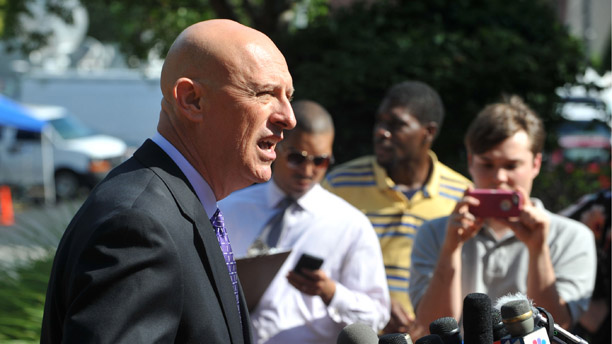Cars come equipped with alarms that remind motorists to buckle their seatbelts, chimes that indicate headlights are still on after the engine is turned off and buzzers that sound if keys are left in the ignition, says Janette Fennell. Forget a sleeping child in the rear seats, however, and drivers are on their own.
Fennell, founder and president of Kids and Cars, a nonprofit organization that advocates for children's traffic safety, is trying to change that. The group filed a petition Monday with the White House, asking the federal government to provide funds for research and development of technology that can detect a child left in the rear seat of a vehicle.
An average of 38 children die each year in the United States from vehicular heatstroke. More than half of the deaths occur after parents inadvertently leave children in the car. So far in 2014, there have been 17 such deaths in the US, according to Kids and Cars. The most recent came last week in Ridgefield, CT , and July is historically the month when vehicular-heatstroke deaths are most likely to occur.
In a high-profile case from Georgia that occurred last month, authorities have charged Justin Ross Harris with murder in the death of his two-year-old son, Cooper, who perished after spending several hours in the back of a car while his father worked. Cobb County district attorney Vic Reynolds (pictured above) said Justin Harris researched hot-car deaths on his computer in the weeks before the incident occurred.
But cases involving criminal intent are rare . Kids and Cars has examined more than 670 vehicular heatstroke deaths of the past 20 years, with the vast majority involve caring parents and caregivers who made one tragic mistake, often when an everyday routine was interrupted.
"These memory errors are committed by normal, attentive and loving parents," says David Diamond, a neuroscientist at the University of South Florida who studies memory. "Many of these parents had believed that they could never forget their children, until their children died."
Two years ago, the Children's Hospital Of Philadelphia studied a smattering of new technologies designed to remind drivers about rear-seat occupants and child-seat occupants. It concluded such devices were "inconsistent and reliable in their performance." Among the problems, the devices interfered with other electronic devices, didn't function in the presence of liquids and often worked only with precise positioning of a child in the restraint. "The devices require considerable effort from the parent/caregiver to ensure smooth operation, and often that operation is not consistent," the study's authors wrote.
In the petition, Kids and Cars asks the Obama administration to provide funding for researching new technology, to identify feasible and effective solutions and to require installation of the technology in all vehicles, or alternatively, all child safety seats. The petition must collect 100,000 signatures by August 13 to ensure the White House staff will review it and send it to the Department of Transportation.
Fennell, founder and president of Kids and Cars, a nonprofit organization that advocates for children's traffic safety, is trying to change that. The group filed a petition Monday with the White House, asking the federal government to provide funds for research and development of technology that can detect a child left in the rear seat of a vehicle.
An average of 38 children die each year in the United States from vehicular heatstroke. More than half of the deaths occur after parents inadvertently leave children in the car. So far in 2014, there have been 17 such deaths in the US, according to Kids and Cars. The most recent came last week in Ridgefield, CT , and July is historically the month when vehicular-heatstroke deaths are most likely to occur.
In a high-profile case from Georgia that occurred last month, authorities have charged Justin Ross Harris with murder in the death of his two-year-old son, Cooper, who perished after spending several hours in the back of a car while his father worked. Cobb County district attorney Vic Reynolds (pictured above) said Justin Harris researched hot-car deaths on his computer in the weeks before the incident occurred.
But cases involving criminal intent are rare . Kids and Cars has examined more than 670 vehicular heatstroke deaths of the past 20 years, with the vast majority involve caring parents and caregivers who made one tragic mistake, often when an everyday routine was interrupted.
"These memory errors are committed by normal, attentive and loving parents," says David Diamond, a neuroscientist at the University of South Florida who studies memory. "Many of these parents had believed that they could never forget their children, until their children died."
Two years ago, the Children's Hospital Of Philadelphia studied a smattering of new technologies designed to remind drivers about rear-seat occupants and child-seat occupants. It concluded such devices were "inconsistent and reliable in their performance." Among the problems, the devices interfered with other electronic devices, didn't function in the presence of liquids and often worked only with precise positioning of a child in the restraint. "The devices require considerable effort from the parent/caregiver to ensure smooth operation, and often that operation is not consistent," the study's authors wrote.
In the petition, Kids and Cars asks the Obama administration to provide funding for researching new technology, to identify feasible and effective solutions and to require installation of the technology in all vehicles, or alternatively, all child safety seats. The petition must collect 100,000 signatures by August 13 to ensure the White House staff will review it and send it to the Department of Transportation.






Bravo to these kids! I can't imagine what it would be like to die from heat exposure.